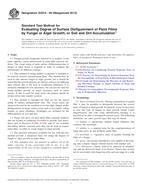We need your consent to use the individual data so that you can see information about your interests, among other things. Click "OK" to give your consent.
ASTM D4541-09e1
Standard Test Method for Pull-Off Strength of Coatings Using Portable Adhesion Testers (Includes all amendments And changes 9/12/2017).
Automatically translated name:
Standard Test Method for Pull-Off Strength of Coatings Using Portable Adhesion Testers
STANDARD published on 1.2.2009
The information about the standard:
Designation standards: ASTM D4541-09e1
Note: WITHDRAWN
Publication date standards: 1.2.2009
SKU: NS-27642
The number of pages: 16
Approximate weight : 48 g (0.11 lbs)
Country: American technical standard
Category: Technical standards ASTM
The category - similar standards:
Annotation of standard text ASTM D4541-09e1 :
Keywords:
adhesion, coatings, field, metal substrates, paint, portable, pull-off strength, tensile test, Adhesion--paints/related coatings/materials, Coatings (paint/related applications), Failure end point--paints/related coatings, Fixed alignment adhesion tester, Loading tests, Portable adhesion testers, Protective coatings, Pull testing, Self-aligning adhesion tester, Stress, Surface analysis--paints/related coatings/materials, ICS Number Code 87.040 (Paints and varnishes)
Additional information
| Significance and Use | ||||||||||||
|
The pull-off strength of a coating is an important performance property that has been used in specifications. This test method serves as a means for uniformly preparing and testing coated surfaces, and evaluating and reporting the results. This test method is applicable to any portable apparatus meeting the basic requirements for determining the pull-off strength of a coating. Variations in results obtained using different devices or different substrates with the same coating are possible (see Section 11). Therefore, it is recommended that the type of apparatus and the substrate be mutually agreed upon between the interested parties. The purchaser or specifier shall designate a specific test method, that is, B, C, D, E, or F when calling out this standard. |
||||||||||||
| 1. Scope | ||||||||||||
|
1.1 This test method covers a procedure for evaluating the pull-off strength (commonly referred to as adhesion) of a coating system from metal substrates. Pull-off strength of coatings from concrete is described in Test Method D 7234. The test determines either the greatest perpendicular force (in tension) that a surface area can bear before a plug of material is detached, or whether the surface remains intact at a prescribed force (pass/fail). Failure will occur along the weakest plane within the system comprised of the test fixture, adhesive, coating system, and substrate, and will be exposed by the fracture surface. This test method maximizes tensile stress as compared to the shear stress applied by other methods, such as scratch or knife adhesion, and results may not be comparable. Note 1—The procedure in this standard was developed for metal substrates, but may be appropriate for other rigid substrates such as plastic and wood. Factors such as loading rate and flexibility of the substrate must be addressed by the user/specifier. 1.2 Pull-off strength measurements depend upon both material and instrumental parameters. Results obtained by each test method may give different results. Results should only be assessed for each test method and not be compared with other instruments. There are five instrument types, identified as Test Methods B-F. It is imperative to identify the test method used when reporting results. Note 2—Method A, which appeared in previous versions of this standard, has been eliminated as its main use is for testing on concrete substrates (see Test Method D 7234). 1.3 This test method uses a class of apparatus known as portable pull-off adhesion testers. They are capable of applying a concentric load and counter load to a single surface so that coatings can be tested even though only one side is accessible. Measurements are limited by the strength of adhesion bonds between the loading fixture and the specimen surface or the cohesive strengths of the adhesive, coating layers, and substrate. 1.4 This test can be destructive and spot repairs may be necessary. 1.5 The values stated in MPa (inch-pound) units are to be regarded as the standard. The values given in parentheses are for information only. 1.6 This standard does not purport to address all of the safety concerns, if any, associated with its use. It is the responsibility of the user of this standard to establish appropriate safety and health practices and determine the applicability of regulatory limitations prior to use. |
||||||||||||
| 2. Referenced Documents | ||||||||||||
|
Similar standards:
Historical
1.12.2008
Historical
1.7.2011
Historical
1.6.2010
Historical
1.2.2012
Historical
1.10.2013
Historical
1.6.2011
We recommend:
Updating of laws
Do you want to be sure about the validity of used regulations?
We offer you a solution so that you could use valid and updated legislative regulations.
Would you like to get more information? Look at this page.



 ASTM D3134-97(2008)e..
ASTM D3134-97(2008)e.. ASTM D3168-85(2011)..
ASTM D3168-85(2011).. ASTM D3258-04(2010)e..
ASTM D3258-04(2010)e.. ASTM D3273-12
ASTM D3273-12 ASTM D3274-09(2013)..
ASTM D3274-09(2013).. ASTM D3278-96(2011)..
ASTM D3278-96(2011)..
 Cookies
Cookies
